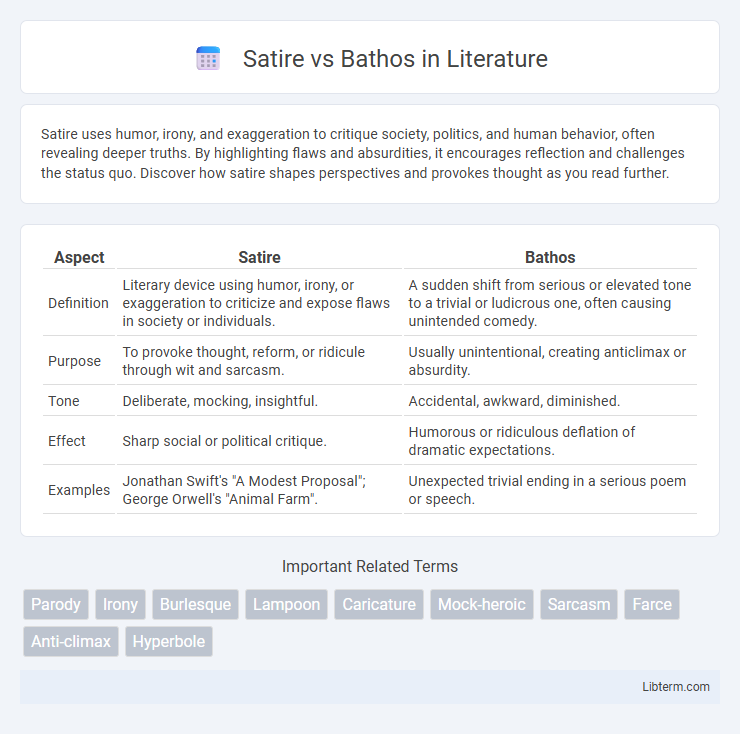Satire uses humor, irony, and exaggeration to critique society, politics, and human behavior, often revealing deeper truths. By highlighting flaws and absurdities, it encourages reflection and challenges the status quo. Discover how satire shapes perspectives and provokes thought as you read further.
Table of Comparison
| Aspect | Satire | Bathos |
|---|---|---|
| Definition | Literary device using humor, irony, or exaggeration to criticize and expose flaws in society or individuals. | A sudden shift from serious or elevated tone to a trivial or ludicrous one, often causing unintended comedy. |
| Purpose | To provoke thought, reform, or ridicule through wit and sarcasm. | Usually unintentional, creating anticlimax or absurdity. |
| Tone | Deliberate, mocking, insightful. | Accidental, awkward, diminished. |
| Effect | Sharp social or political critique. | Humorous or ridiculous deflation of dramatic expectations. |
| Examples | Jonathan Swift's "A Modest Proposal"; George Orwell's "Animal Farm". | Unexpected trivial ending in a serious poem or speech. |
Understanding Satire: Definition and Purpose
Satire is a literary technique that uses humor, irony, or exaggeration to criticize and expose the flaws or vices in society, individuals, or institutions, aiming to provoke thought and encourage change. Its purpose is to enlighten audiences by highlighting absurdities in behavior or beliefs, often prompting reflection or reform. Understanding satire involves recognizing its subtle balance between entertainment and social commentary, distinguishing it from mere mockery or triviality.
What is Bathos? Origins and Meanings
Bathos originates from the Greek word meaning "depth," signifying an unintended descent from the sublime to the trivial or ridiculous in literature and art. It describes a sudden shift in tone that aims for seriousness but results in humorous or absurd effects, often highlighting the disparity between intention and execution. Bathos is distinct from satire, as it lacks the critical edge and social commentary central to satirical works.
Satire and Bathos: Key Differences
Satire employs humor, irony, and exaggeration to criticize and expose societal flaws, aiming to provoke thought and reform. Bathos, in contrast, often results from an abrupt shift from the serious to the trivial, creating an unintentional anticlimax that undermines the intended emotional impact. These key differences highlight satire's deliberate critique versus bathos' accidental descent into absurdity.
Historical Development of Satire and Bathos
Satire originated in ancient Rome with poets like Horace and Juvenal using humor and irony to critique societal vices, evolving through the Renaissance with figures like Jonathan Swift who sharpened its cultural impact. Bathos emerged in the 18th century as a literary technique invented by Alexander Pope to describe a sudden drop from the sublime to the ridiculous, often used for comedic effect. The historical development of satire reflects its role as a vehicle for social commentary, while bathos highlights the manipulation of emotional tone to create contrast or absurdity.
Famous Examples of Satire in Literature
Jonathan Swift's "A Modest Proposal" serves as a quintessential example of satire, using exaggerated irony to critique social and economic policies. Similarly, George Orwell's "Animal Farm" employs allegorical satire to expose the dangers of totalitarianism and political corruption. These works leverage humor and irony to provoke critical reflection on societal issues, distinguishing them from bathos, which unintentionally shifts from serious to ludicrous.
Notable Instances of Bathos in Art and Media
Notable instances of bathos in art and media often emerge in films such as Mel Brooks' "Blazing Saddles," where absurd shifts from dramatic tension to slapstick humor highlight the technique's comedic impact. In literature, Alexander Pope's use of bathos in "The Rape of the Lock" deliberately subverts epic conventions by contrasting lofty language with trivial subjects, creating a humorous effect. Television shows like "The Simpsons" frequently employ bathos by juxtaposing serious themes with sudden ridiculous moments, enhancing satire through unexpected emotional deflation.
The Psychological Impact of Satire vs Bathos
Satire exploits sharp humor and irony to provoke critical thinking and challenge societal norms, often leading to increased self-awareness and social engagement. In contrast, bathos abruptly shifts from the serious to the trivial or ridiculous, causing emotional deflation and sometimes confusion, which can undermine the intended message and hinder psychological reflection. Understanding the psychological impact of satire versus bathos reveals how satire fosters cognitive stimulation, while bathos may prompt unintended disengagement or emotional detachment.
How Writers Use Satire and Bathos for Effect
Writers use satire to expose and criticize societal flaws by employing humor, irony, and exaggeration, prompting readers to reflect on serious issues through a comedic lens. Bathos, by contrast, deliberately shifts from a lofty or serious tone to an absurd or trivial conclusion, creating a jarring effect that can evoke humor or highlight the disparity between expectation and reality. Both techniques manipulate audience emotions and expectations, with satire targeting critical awareness and bathos provoking surprise or laughter through unexpected tonal drops.
Audience Reactions: Satirical Wit vs Bathetic Humor
Satirical wit engages audiences by provoking critical thinking and highlighting societal flaws through clever irony and sarcasm, often eliciting appreciation for intellectual humor. Bathetic humor, in contrast, triggers unintended emotional responses such as embarrassment or disappointment due to its abrupt shift from serious to trivial, leading to awkward or comedic relief. Audience reactions to satire typically involve reflection and insight, whereas bathos often results in laughter derived from the contrast between expected gravity and unexpected silliness.
Choosing Between Satire and Bathos in Creative Writing
Choosing between satire and bathos in creative writing depends on the intended emotional impact and tone. Satire employs humor and irony to critique societal flaws, encouraging readers to reflect and engage critically with the subject matter. Bathos, by contrast, deliberately shifts from the serious to the absurd or trivial, creating a dramatic drop that evokes surprise or humor through exaggerated anticlimax.
Satire Infographic

 libterm.com
libterm.com